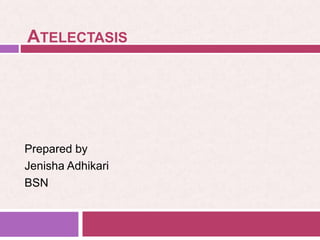
Atelecstasis
- 2. CONTENT INTRODUCTION CAUSES PATHOPHYSIOLOGY SIGN AND SYMPTOMS DIAGNOSIS TREATMENT NURSING MANAGEMENT
- 3. INTRODUCTION Atelectasis is a complete or partial collapse of a lung or lobe of a lung develops when the tiny air sacs (alveoli) within the lung become deflated.
- 4. The amount of lung tissue involved in atelectasis is variable, depending on the cause. Atelectasis can make breathing difficult and lower oxygen particularly if lung disease is already present. Treatment depends on the cause and severity of the collapse.
- 6. Types Resorptive Atelectasis When airways are obstructed there is no further ventilation to the lungs and beyond. In the early stages, blood flow continues and gradually the oxygen and nitrogen get absorbed, resulting in atelectasis. Resorption atelectasis is another type of atelectasis that occurs when an obstruction in the lungs prevents air from reaching the airways. The air is absorbed into the surrounding areas and the alveoli collapse
- 7. Relaxation Atelectasis The lung is held close to the chest wall because of the negative pressure in the pleural space. Once the negative pressure is lost the lung tends to recoil due to elastic properties and becomes atelectatic. This occurs in patients with pneumothorax and pleural effusion. In this instance, the loss of negative pressure in the pleura permits the lung to relax, due to elastic recoil. There is common misconception that atelectasis is due to compression.
- 8. Cont.. Adhesive Atelectasis Surfactant reduces surface tension and keeps the alveoli open. In conditions where there is loss of surfactant, the alveoli collapse and become atelectatic. In ARDS this occurs diffusely to both lungs. In pulmonary embolism due to loss of blood flow and lack of CO2, the integrity of surfactant gets impaired.
- 9. Cicatricial Atelectasis Alveoli gets trapped in scar and becomes atelectatic in fibrotic disorders. Round Atelectasis An instance where the lung gets trapped by pleural disease and is devoid of air. Classically encountered in asbestosis
- 10. Pathophysiology Resorption or obstructive atelectasis due to intrinsic or extrinsic airway obstruction Passive atelectasis from diaphragmatic dysfunction and hypoventilation Compressive atelectasis from lung tissue compression and ineffective alveolar expansion from intra or thoracic forces Adhesive atelectasis due to increased surface tension
- 11. CAUSES The most common cause is post-surgical atelectasis, characterized by splinting, i.e. restricted breathing after abdominal surgery whereas other causes are; Smoking Pulmonary TB Mucus plug Foreign body Blood clot Tumor in major airway Injury Pleural effusion Scarring of lung tissue Pneumonia
- 12. Risk Factor Age — being younger than 3 or older than 60 years of age. Any condition that interferes with spontaneous coughing, yawning and sighing. Confinement to bed with infrequent changes of position. Impaired swallowing function, particularly in older adults — aspirating secretions into the lungs is a major source of infections. Lung disease, such as asthma in children, COPD, bronchiectasis or cystic fibrosis.
- 13. Cont.. Premature birth. Recent abdominal or chest surgery. Recent general anesthesia. Respiratory muscle weakness, due to muscular dystrophy, spinal cord injury or another neuromuscular condition Any cause of shallow breathing — including medications and their side effects, or mechanical limitations, such as abdominal pain or rib fracture, for example.
- 14. Signs and symptoms May have no signs and symptoms or they may include cough, but not prominent; chest pain (not common); breathing difficulty (fast and shallow); low oxygen saturation; pleural effusion (transudate type); cyanosis (late sign); increased heart rate. fever
- 15. Complication Low blood oxygen (hypoxemia). Pneumonia. Respiratory failure.
- 16. Diagnosis Chest X-ray CT scan Oximetry Bronchoscopy
- 17. Treatment Treatment is directed at correcting the underlying cause 1. Due to surgery Perform deep breathing exercises. Change your position. Make an effort to cough. 2. Pressure From Outside the Lungs If pressure from outside the lungs causes atelectasis, then treat the cause of the pressure. For example, if the cause is a tumor or fluid buildup, remove the tumor or fluid. This will allow the lung to fully expand.
- 18. 3. Blockage If a blockage causes atelectasis, you'll receive treatment to remove the blockage or relieve it. If the blockage is from an inhaled object, such as a peanut, your doctor will remove it during bronchoscopy If a mucus plug is blocking the airways, doctor may use suction to remove it also Chest clapping or percussion , Postural drainage and several Medicines can remove the mucus.
- 19. Use aerosolized respiratory treatments (inhaled medications) to open the airway Treat tumor or other condition
- 20. Nursing Management Assessment History taking Physical examination X ray
- 21. Cont.. Nursing Diagnosis Impaired Gas Exchange related to alveolar-capillary membrane dysfunction. Ineffective breathing pattern related to excessive mucus production and thick,ineffective cough. Impaired gas exchange related to lung volume reduction Activity Intolerance related to weak body condition secondary to increased respiratory effort. Risk for fluid volume deficit related to fever fluid loss, fluid intake is less because of dyspnoea. Acute Pain related to lung inflammation
- 22. Cont.. Nursing Intervention Encourage the patient to perform coughing and deep- breathing exercises every 1 to 2 hours. Help the patient use an incentive spirometer to encourage deep breathing. Gently reposition the patient often and help them walk as soon as possible. Administer adequate analgesics to control pain. Humidify inspired air and encourage adequate fluid intake to mobilize secretions. Provide suctioning as needed for patients who are intubated or unable to clear their own secretions.
- 23. Cont.. Administer sedatives with care because these medications depress respirations and cough reflex. Use postural drainage and chest percussion to remove secretions. Offer reassurance and emotional support because the patient’s limited breathing capacity may frighten him. Assess breath sounds and respiratory status frequently. Report any changes immediately. Evaluate the patient’s ability to perform bronchial hygiene. Monitor pulse oximetry readings and ABG values for evidence of hypoxia. Demonstrate comfort measures to promote relaxation and conserve energy.